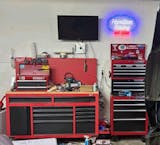LED Flex Neon vs Glass Neon Signs: 11 Key Differences Every Business Owner Should Know
When starting a business, one of the most important investments is your signage. A well-designed sign not only attracts attention but also acts as a silent salesperson, reinforcing your brand day and night. Among the most popular options are traditional glass neon signs and the modern flex (LED) neon signs. But which one is right for your business?
Below, we break down 11 key differences between glass neon and flex LED neon signs to help you make an informed decision.
1. Source of Light
Glass Neon: Uses neon or argon gas fluorescents.
Flex Neon: Uses LED semiconductors, which are brighter, eco-friendly, and consume 5–10× less energy.
2. Input Voltage
Glass Neon: Requires high voltage (3KV–18KV).
Flex Neon: Runs safely at 24V/120V, reducing risk and energy costs.
3. Lifespan
Glass Neon: ~10,000 hours on average.
Flex Neon: ~30,000+ hours, up to 3× longer.
4. Ease of Installation
Glass Neon: Requires a skilled artisan for bending and installation.
Flex Neon: Lightweight and DIY-friendly; can be cut, shaped, and mounted with minimal expertise.
5. Durability
Glass Neon: Fragile and prone to breakage.
Flex Neon: Flexible, PVC-based, flame-retardant, and shatterproof.
6. Environmental Impact
Glass Neon: Historically linked to mercury contamination.
Flex Neon: Mercury-free, recyclable, and energy-efficient.
7. Price
Glass Neon: Slightly higher costs, plus maintenance.
Flex Neon: Often more affordable upfront and cheaper to operate.
8. Maintenance
Glass Neon: Requires periodic gas refilling and professional servicing.
Flex Neon: Virtually maintenance-free.
9. Safety
Glass Neon: Breakable glass and potential mercury exposure.
Flex Neon: Shockproof, emits minimal heat, safe to touch, and easy to dispose of.
10. Brightness
Glass Neon: Produces a warm glow.
Flex Neon: Brighter, clearer, and more visible from long distances.
11. Accessibility & Control
Glass Neon: Reliable but limited to basic on/off functionality.
Flex Neon: Can include remote controls, dimmers, RGB colour-changing, and even app control.
Verdict: Why Flex Neon is the Better Choice
While traditional glass neon offers a nostalgic glow, it falls short in durability, safety, and energy efficiency. Flex LED neon signs provide a modern solution that’s more sustainable, cost-effective, and versatile. From lower running costs to longer lifespan, Flex Neon offers clear advantages for today’s businesses.
Still, the choice depends on your brand vision. For businesses seeking authentic retro aesthetics, glass neon remains a classic. But for those prioritising affordability, flexibility, and eco-friendliness, flex LED neon is the way forward.
Get Expert Help from Neonific
Choosing the right sign doesn’t have to be overwhelming. At Neonific, our team of experts can guide you through the design and production process, ensuring your investment delivers maximum value. Whether you need a custom logo sign, open sign, or unique neon wall art, we’ll help you create signage that truly makes your brand shine.
FAQ: Flex (LED) Neon vs Glass Neon Signs
Are flex (LED) neon signs better than glass neon?
It depends on your goal. Flex LED neon typically wins for durability, energy efficiency, safety, and cost. Traditional glass neon offers a classic, warmer glow and nostalgic look.
How long do LED neon signs last compared to glass neon?
LED neon typically lasts ~30,000+ hours, while glass neon averages around ~10,000 hours. Actual lifespan varies by size, brightness settings, and usage conditions.
Are LED neon signs safe?
Yes. LED neon runs at low voltage (often 12–24V), stays cool to the touch, and uses shatter-resistant materials. For peace of mind, choose products that meet local electrical standards (e.g., CE/UKCA/CSA).
Can LED neon signs be used outdoors?
Yes—if specified as outdoor-rated. Ask for weatherproof builds (with appropriate IP rating) for exterior shopfronts or exposed installations.
Do LED neon signs use less energy than glass neon?
Yes. LED neon can use about 5–10× less energy than comparable glass neon, depending on size and brightness.
Which is brighter—LED neon or glass neon?
LED neon is often perceived as brighter and crisper at a distance, while glass neon delivers a warmer, classic glow.
Is LED neon easy to install?
Most LED neon is plug-and-play and lightweight, suitable for wall mounting or hanging. For large signs or permanent wiring, consult a qualified installer.
What maintenance do LED neon signs need?
Minimal. Generally just occasional dusting. Unlike glass neon, there’s no gas refill or glass tube servicing.
Can you recreate detailed logos and small lettering in LED neon?
Yes. With rigid acrylic LED builds, we can produce fine details—like the dot on an “i”—without elongating shapes, ideal for intricate logos and typography.
How much do custom LED neon signs cost?
Pricing depends on size, complexity, colours, and features (e.g., dimming, RGB). Share your design for a tailored quote.





